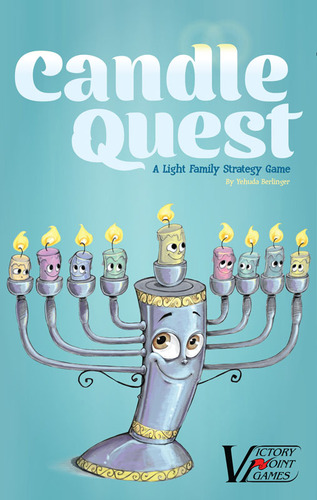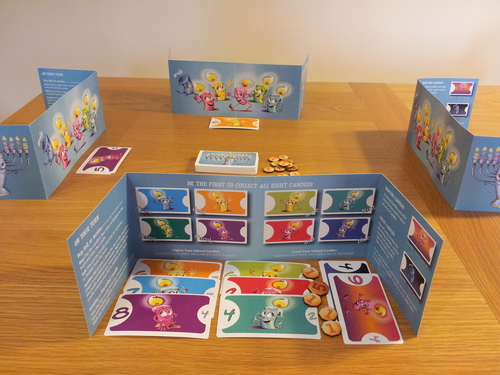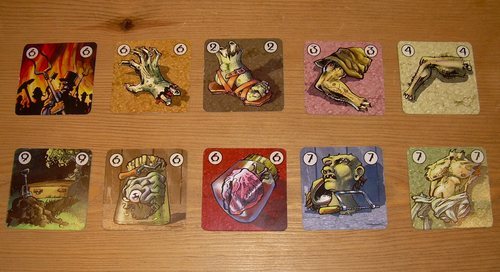An Interview with Yehuda Berlinger—Designer of Candle Quest
/ Today we're talking with Yehuda Berlinger, designer of It's Alive!, and the recently released Candle Quest, which uses the same mechanics in a game about Hanukkah.
Today we're talking with Yehuda Berlinger, designer of It's Alive!, and the recently released Candle Quest, which uses the same mechanics in a game about Hanukkah.
Yehuda, thanks for taking the time to chat with us!
Happy to oblige.
Candle Quest, the original theme of the auction game It’s Alive!, has finally been released by Victory Point Games. Was the theme/holiday the motivation for the game? Or were you creating an auctioning game and looking for a theme to work within?
The original original theme was actually an “electrical safety” game. The eight items you needed to collect were safety tips for handling electricity. The idea of collection came pretty easily, and the idea of three simple choices on each turn, and there being an auction, was inspired by the simplicity of Reiner Knizia’s designs. I hadn’t seen any games where the auction didn’t come back to you, so I went with that. It turned out to be a new and interesting mechanic.
After I completed the first version of the game, which didn’t take long, the people who asked me to do the game said that the opportunity with the Israel Electric Company had passed, but that they might be interested in making the same game with a different theme, something to do with space aliens. They created a mockup with stock alien pictures in spaceships. After very little development, they offered me a small sum for the game, and I said I would have to think about it. Less than 12 hours later they had decided to work with someone else to make a game instead.
My game group and I, especially my friend Nadine Wildmann, played around with the game again, changing some more rules (making the bad cards less bad, mostly) and tossing around ideas for collection themes, including eight candles for a menorah, eight reindeer for Santa’s sleigh, etc. Eventually I did a mockup for The Menorah Game and took it to BGG.con in 2005 in order to sell the game to publishers. I brought prototypes with me to give to publishers, and I mailed some out, but BGG people bought all of the rest of them (even though they were pretty crappy).
I don’t remember the path that got from there to Jackson Pope at Reiver Games, but eventually it did, about a year later. He changed the theme to Frankenstein and the name to It’s Alive, and added cartoonish gory pictures, assuming that such a theme would sell better to gamers than a menorah-themed game would. He was probably right, but it also limited the audience to gamers, and older ones, in my opinion.
After I got back the rights, Jeremy Maher asked me to license him the game to make an app, which is currently available in both Android and iOS editions.
What was still needed was a game that would appeal to non-gamers and families. Nadine and I, as well as friends of ours Bill and Shirley Burdick, tossed around some more ideas. Turns out that Bill, Nadine, and I were all working on new games, and we thought it would be good to publish It’s Alive again in a more family friendly version as part of a new company, which we called Gilead Games. The new game would go back to the Hanukkah theme. This would appeal to Jewish families, since there are no other good Hanukkah games available, and hopefully to all families, since there is little Jewish about the game other than the fact that it has a menorah and the coins are called shekels.
Nadine did most of the work; Bill, Shirley, and I provided encouragement.
 Before Victory Point Games picked up Candle Quest, you made an attempt at bringing the game to market via Kickstarter. What did you learn through that process?
Before Victory Point Games picked up Candle Quest, you made an attempt at bringing the game to market via Kickstarter. What did you learn through that process?
Well, I actually learned a lot from the article I wrote on Purple Pawn (How to Succeed or Fail on Kickstarter), and we knew that we would either get to 10% funding within 24 hours or we would probably not succeed. I thought that I had enough people who would be interested because many people know my blog and BGG persona. Unfortunately, most of these people are gamers who already own It’s Alive (or don’t want to) and are not the target audience for Candle Quest.
A smaller amount of support came from friends, family, and synagogue members, but it was quickly clear that this was nowhere near enough. Your fan base really determines the type of support you can expect on KS. We had a mismatch between the game we were making and the audience that needed to support it.
I think the audience for Candle Quest is HUGE. There is simply no other good original Jewish-themed game, anywhere, other than something like Jewish-themed Apples to Apples or Jewish-themed Chess, etc. Candle Quest is a gateway game with crossover appeal to non-gamers and easy for kids to play, but a real solid game for Eurogamers and adults. It’s not for everyone, of course, but so far about 80% of the people who play it like it, and some are real fans who want to play it over and over. It plays quickly and rewards experienced play without letting experience dominate.
So the simple republishing of the game through VPG is not the end of the story, but just the beginning. We have to get the game out to Jewish distributors and stores and hopefully hit a tipping point where it catches on with the public (and friends tell friends, etc). The KS process helped us focus all of that: how to estimate the publication costs, how to figure out the market, etc. And in the end, how to find the right publisher.
Now that Candle Quest is published, what’s next for you?
I hope Candle Quest will come out as an app, like It’s Alive did, and I see no reason not to also use the base game to create the Santa’s reindeer version, or other themed versions, for that matter.
Nadine is currently showcasing her own board game prototype to publishers and Bill is polishing up an RPG he created that has gone through extensive playtesting. He/we are considering how to change its theme to something biblical, since we think Gilead Games could occupy a niche as a publisher of biblically themed games. There are some publishers of Jewish games, but they publish bad games or re-themes of other games, and there are some publishers of Christian games, some of whom are not bad. But it’s still a large market with few serious players.
We’re a talented bunch of people with some good ideas, and we’re having fun with the ideas.
What are some of your favorite board games right now?
I love Go, though I’m bad at it, and I’m still a huge fan of Puerto Rico. I also love Bridge and other partnership card games like Tichu, Anagrams, and Scrabble; Magic: The Gathering (but only for fun playing with random cards, not constructed), and the other games I rate highly on BGG of course.
How is gaming different in Israel than here in the States?
I’ve written about this a few times. It depends on what you mean by gaming.
For Eurogames, we have some loosely organized forums and groups and about a 500-1000 players. If you include Settlers of Catan, Munchkin/Steve Jackson Games, and Fantasy Flight Games (i.e. the publishers who actually have reps in Israel), the number would jump to something like 3-5,000, I estimate. Add CCGs and RPGs, and you’re talking about 10,000.
But most gaming here refers to the classics. We have huge amounts of Chess and Backgammon players, a few large Bridge and Scrabble clubs, and a lot of people playing Monopoly, Taki (like UNO), and other bad games, many of which have Jewish or Moslem moralistic themes.
Access to Eurogames and CCGs is hard, and so expensive, because the market is small so it all has to be shipped, and taxes are high (VAT on everything sold).
Language is a barrier, since most people read Hebrew or Arabic, and while many adults can get along in English, they would prefer not to have to. So many importers try to provide the games with Hebrew instructions or republish the game in Hebrew. I don’t know much about the Arab market, but some Moslem populations, like some ultra-Orthodox Jewish populations, frown on the imported culture, lack of modesty, and fantasy themes that are prevalent in board games.
Ok, the rapid-fire section! We ask the questions; you answer them with one word (or super-short phrase)! And, GO!
Favorite movie with a numeral in it?
Terminator 2
Fairytale by Donovan. :-)
Last meal on death row?
All you-can eat Chinese with an unlimited time to eat it? What am I doing on death row? Help! Probably fasting, since that is the appropriate Jewish action for doing penance (like on Yom Kippur).
Favorite character in a TV show?
Lorelai Gilmore
Last great book you read?
Yoreh De’ah of the Shulchan Aruch :-)
Ok, The English Patient.
Thanks for answering our questions, Yehuda! And thank you for reading! You can check out Candle Quest right here.

















